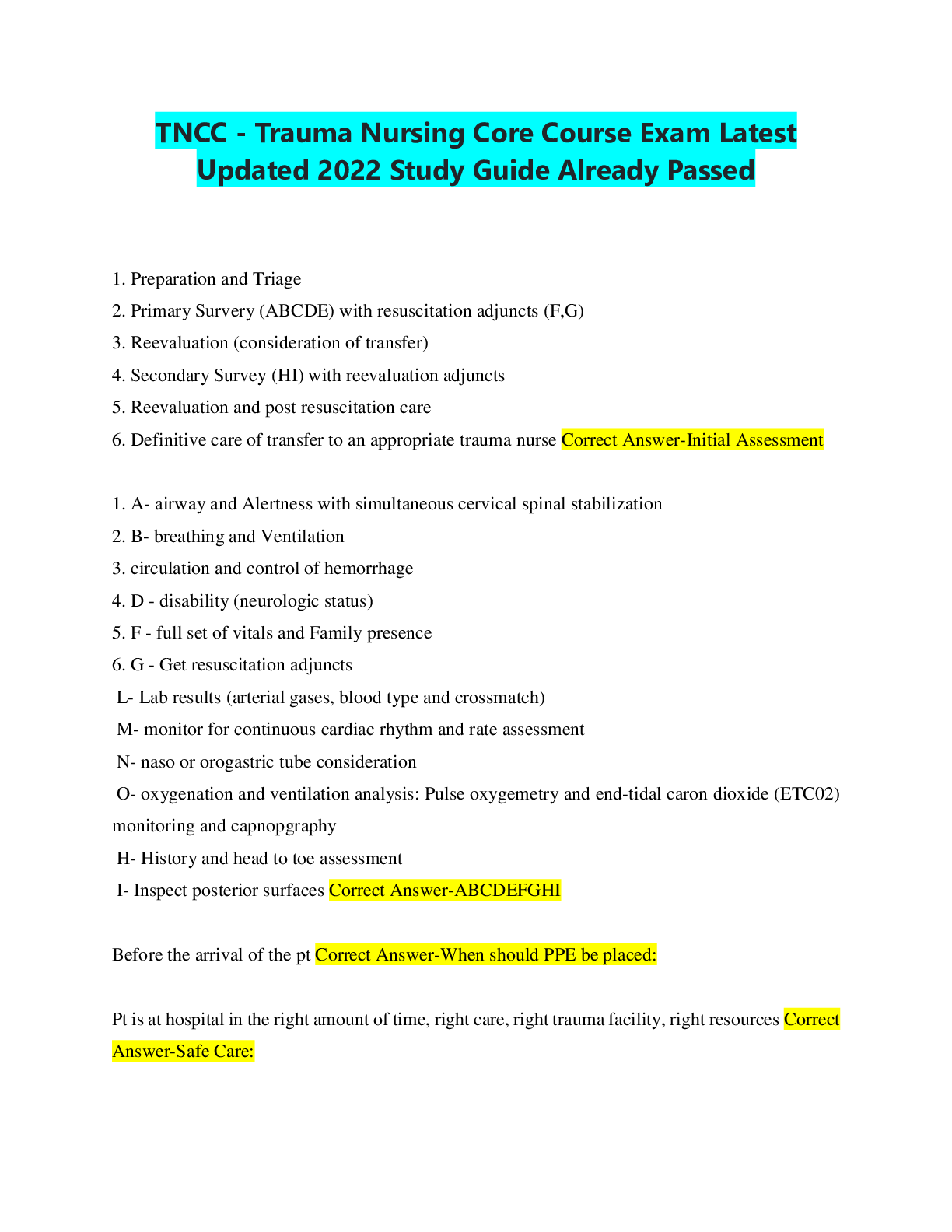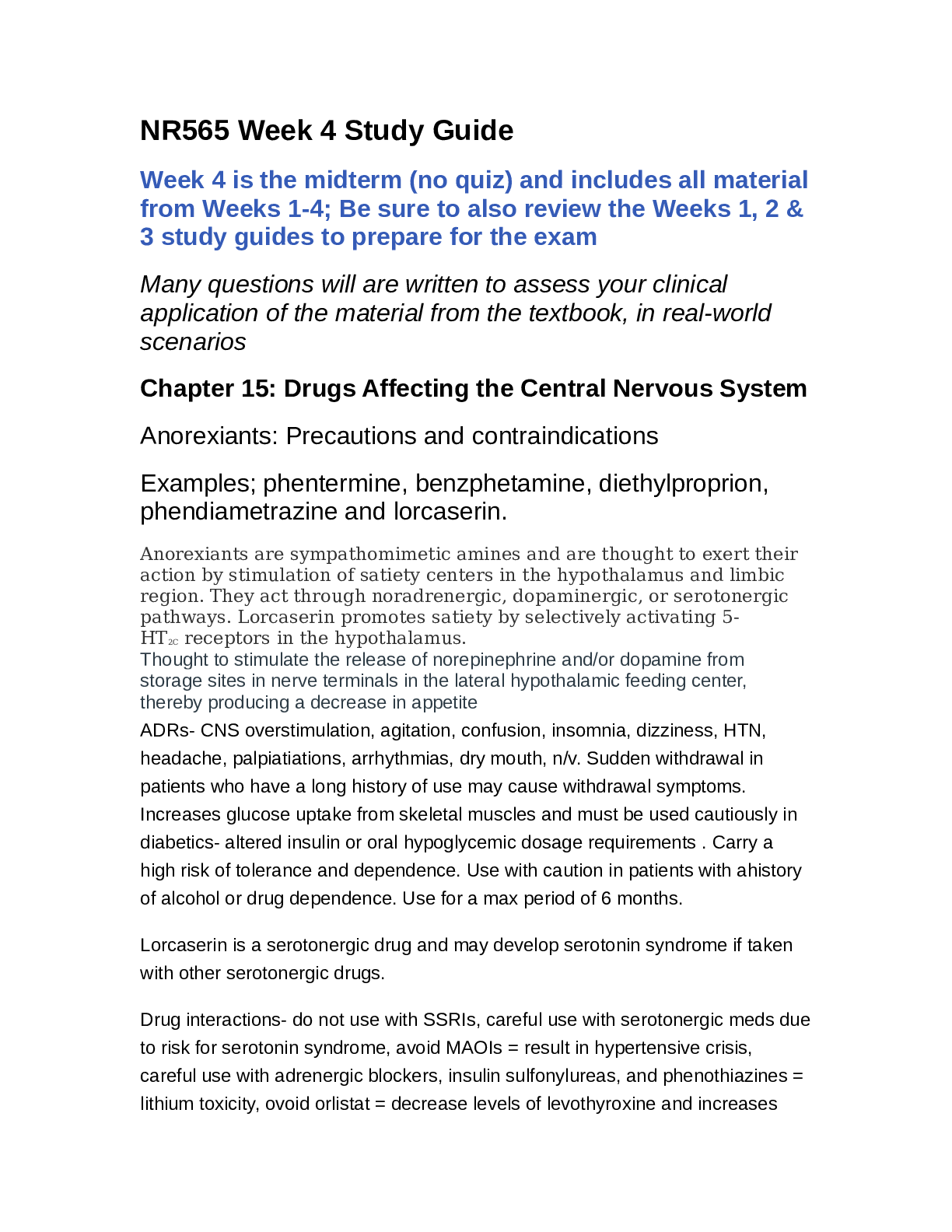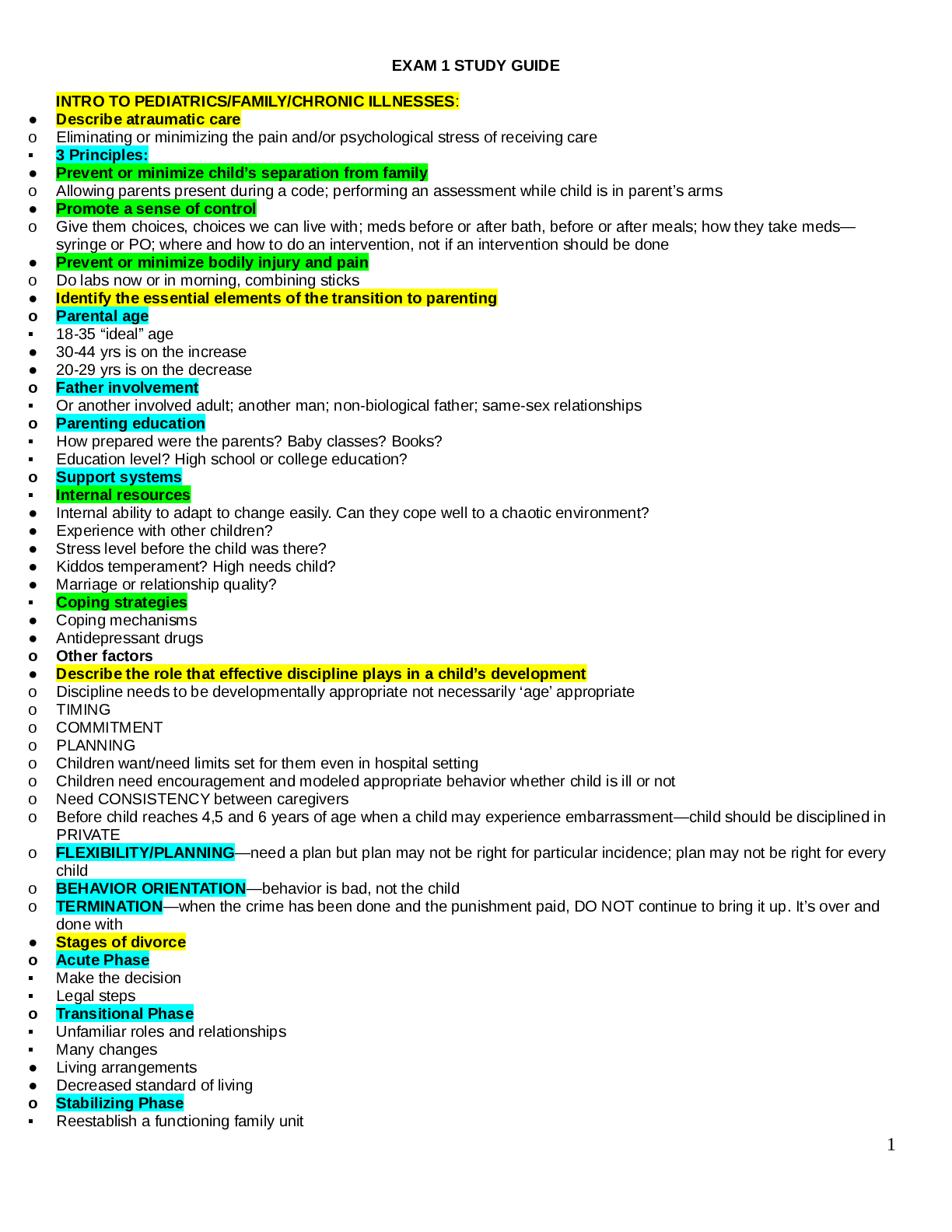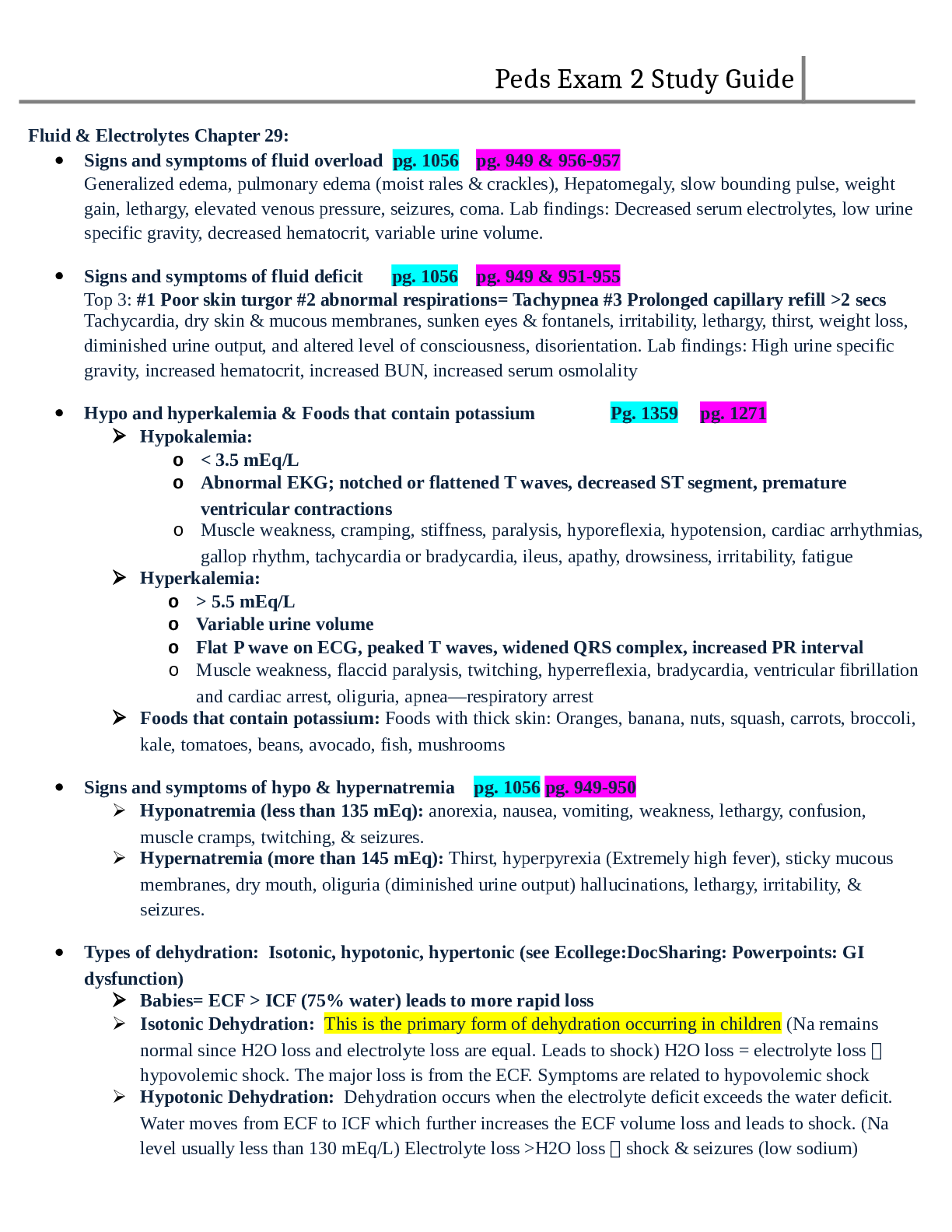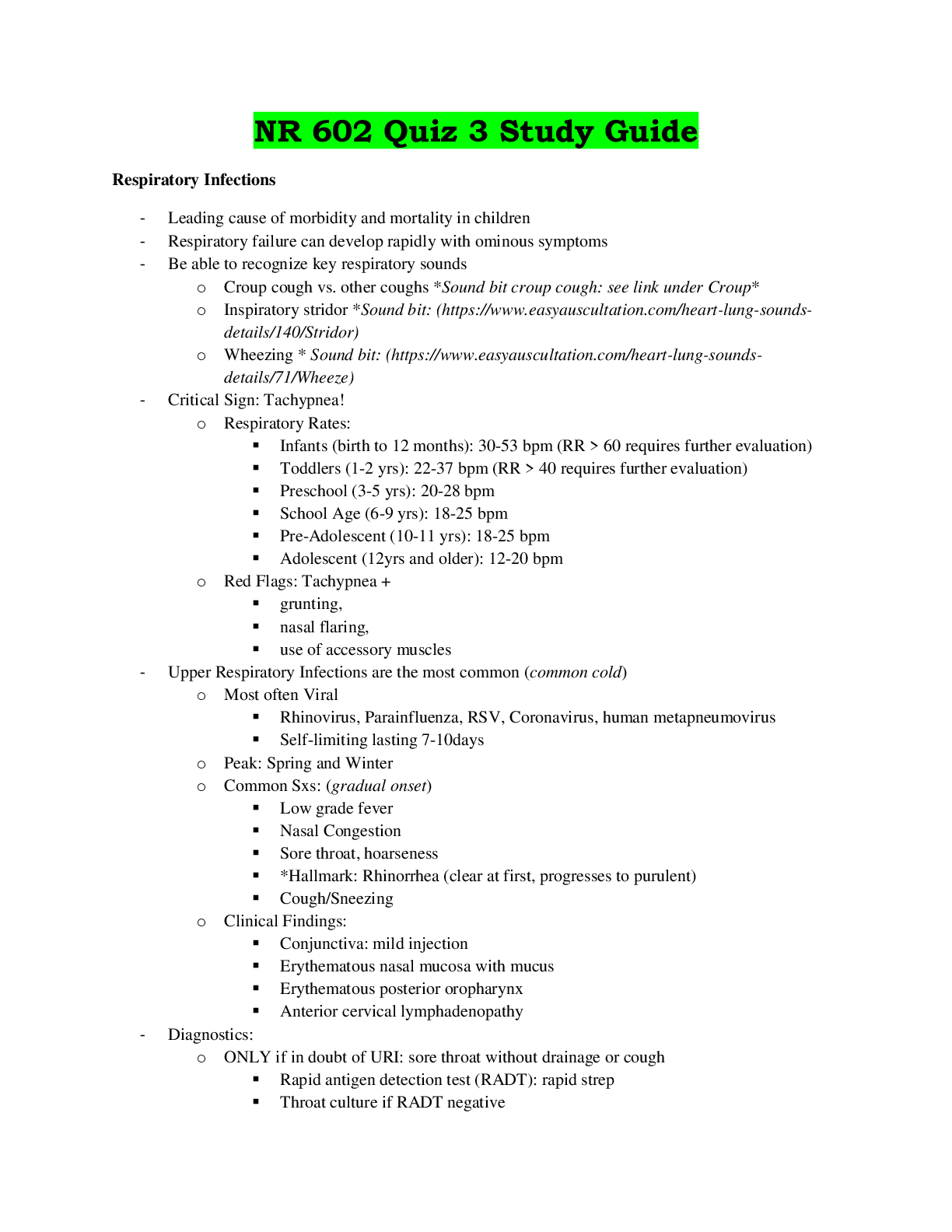*NURSING > STUDY GUIDE > NR 507 Patho midterm study guide completed and Rated A (All)
NR 507 Patho midterm study guide completed and Rated A
Document Content and Description Below
Mid-Term Study Guide Week 4 review concepts related to anticholinergic drugs and the treatment for asthma, bronchitis and associated pathogenesis; chronic bronchitis and related acid/base disturban... ces, perfusion, blood flow between the heart and lungs, asthma signs and symptoms, bronchioles, alveolar hyperinflation with asthma, polycythemia vera; mechanism of action of anticholinergic drugs to treat asthma Asthma is a chronic inflammatory disease characterized by sensitization to allergens, bronchial hyperreactivity, and reversible airway obstruction. Asthma is initiated by a type I hypersensitivity reaction primarily mediated by IgE. Airway epithelial exposure to antigen initiates both an innate and an adaptive immune response in sensitized individuals. Many cells and cellular elements contribute to the persistent inflammation of the bronchial mucosa and hyperresponsiveness of the airways, including macrophages (dendritic cells), T helper 2 (Th2) lymphocytes, B lymphocytes, mast cells, neutrophils, eosinophils, and basophils. There is both an immediate (early asthmatic response) and a late (delayed) response. In young children, airway obstruction can be more severe because of the smaller diameter of their airways. Asthma is caused by complex interaction of genetic and environmental factors. Asthma results in excess mucus production and accumulation hypertrophy of bronchial smooth muscle airflow obstruction decreased alveolar ventilation. Asthma can take two forms: extrinsic and intrinsic. The most common symptoms of both extrinsic and intrinsic asthma are: coughing, wheezing shortness of breath rapid breathing chest tightness Extrinsic: The plugs of mucus and pus from this inflammatory process can block alveolar passageways, leading to air-trapping and hyperinflation more signs and symptoms consistent with the diagnosis of asthma This process is illustrated in this image which shows the airway pathology in its entirety mast cell degranulation triggered by the excessive amounts of IGE that have airingly formed this individual that will bind that allergen as it enters the airway that mast cell degranulation releases chemicals that releases mucus production and accumulation as well as chemicals that contribute to smooth muscle constriction that smooth muscle constriction along with mucus plugs that form result in hyperinflation of the alveoli and eventual erosion of airway tissue Intrinsic: can be triggered by a variety of non-allergic factors, each causing a slightly different variation on the inflammatory process. Regardless of the underlying cause of asthma, the disease process has both a bronchoconstriction component and an inflammation component. Pharmacotherapy focuses on one or both of these components to provide fast relief for acute bronchospasms, as well as long-term control to reduce the frequency of asthma attacks. Chronic Bronchitis: pathogenesis of chronic bronchitis which begins with some sort of exposure to airborne irritants which activates bronchial smooth muscle constriction, mucus secretion, and release of inflammatory mediators (histamine, prostaglandins, leukotrienes, interleukins) from immune cells located in the lamina propria These airborne irritants can include air pollution or industrial chemicals & fumes. But the most common irritant is smoke from cigarettes and other tobacco products. Keep in mind that all of these bronchial responses are, in fact, normal responses to occasional inhalation of airborne irritants. Smooth muscle constriction is important to limit passage of the irritant deeper into the respiratory tract. Secretion of mucus and release of inflammatory chemicals are also important to help trap and defend against a potentially harmful substance. The transition from a normal, protective respiratory response to a detrimental effect occurs with …. long-term exposure to airborne irritants which promotes • smooth muscle hypertrophy à increased bronchoconstriction • hypertrophy and hyperplasia of goblet cells à mucus hypersecretion • epithelial cell metaplasia à non-ciliated squamous cells • migration of more WBCs to site à inflammation & fibrosis in bronchial wall • thickening and rigidity of bronchial basement membrane à narrowing of bronchial passageways the smooth muscle constriction, bronchial wall inflammation, and mucus plugs lead to another issue: alveolar hyperinflation. Because of the anatomical changes in the bronchioles associated with chronic irritation ventilation, especially exhalation, is compromised. Pressure differences during inhalation are high enough to force air into the alveoli. However, during exhalation the narrowing and collapse of the air passageways causes air to be trapped in the alveoli resulting in. • alveolar hyperinflation à expanded thorax • hypercapnia, (CO2 retention) and, respiratory acidosis The high concentration of CO2 creates unfavorable conditions for gas exchange, so there is • decreased O2 exchange à ventilation/perfusion (V/Q) mismatch Decreased perfusion of the pulmonary capillaries with oxygenated blood results in • chronic pulmonary hypoxia à cyanosis Poor ventilation, leading to decreased perfusion, causes Right to Left “shunting” to occur. This is the phenomenon where deoxygenated blood passes from the RV to lungs to the LV without adequate perfusion (gas exchange) Similar to other obstructive pulmonary disorders, chronic bronchitis has both a bronchoconstriction component and an inflammation component. Pharmacotherapy includes: • antitussives and expectorants – can be useful to help thin the secretions for easier expulsion and to help control coughing episodes • bronchodilators – fast- and long-acting agents are mainstays of chronic bronchitis treatment • systemic corticosteroids – particularly useful during an acute flareup/exacerbation. • antibiotics – as needed for treatment of bacterial infections; critical to prevent any excessive immune stimulation Prophylactic immunizations (especially the pneumococcus vaccine and annual flu vaccines) are important to reduce likelihood of exacerbations triggered by respiratory infections. Clients also benefit from working with respiratory and physiotherapists to learn relatively simple physical measures that can help optimize quality of life for clients with chronic bronchitis. These physical measures include: • chest physiotherapy using postural drainage (changes in body position) and gravity to facilitate movement of mucus from the congested lower bronchial airways to the trachea for easier expulsion AND • relaxation and breathing techniques, including pursed lip breathing, similar to how you would blow a bubble, to prolong the exhalation period An anticholinergic agent is a substance that blocks the neurotransmitter acetylcholine in the central and the peripheral nervous system. These agents inhibit parasympathetic nerve impulses by selectively blocking the binding of the neurotransmitter acetylcholine to its receptor in nerve cells. The nerve fibers of the parasympathetic system are responsible for the involuntary movement of smooth muscles present in the gastrointestinal tract, urinary tract, lungs, and many other parts of the body. Anticholinergics are divided into three categories in accordance with their specific targets in the central and peripheral nervous system: antimuscarinic agents, ganglionic blockers, and neuromuscular blockers [Show More]
Last updated: 2 years ago
Preview 1 out of 45 pages
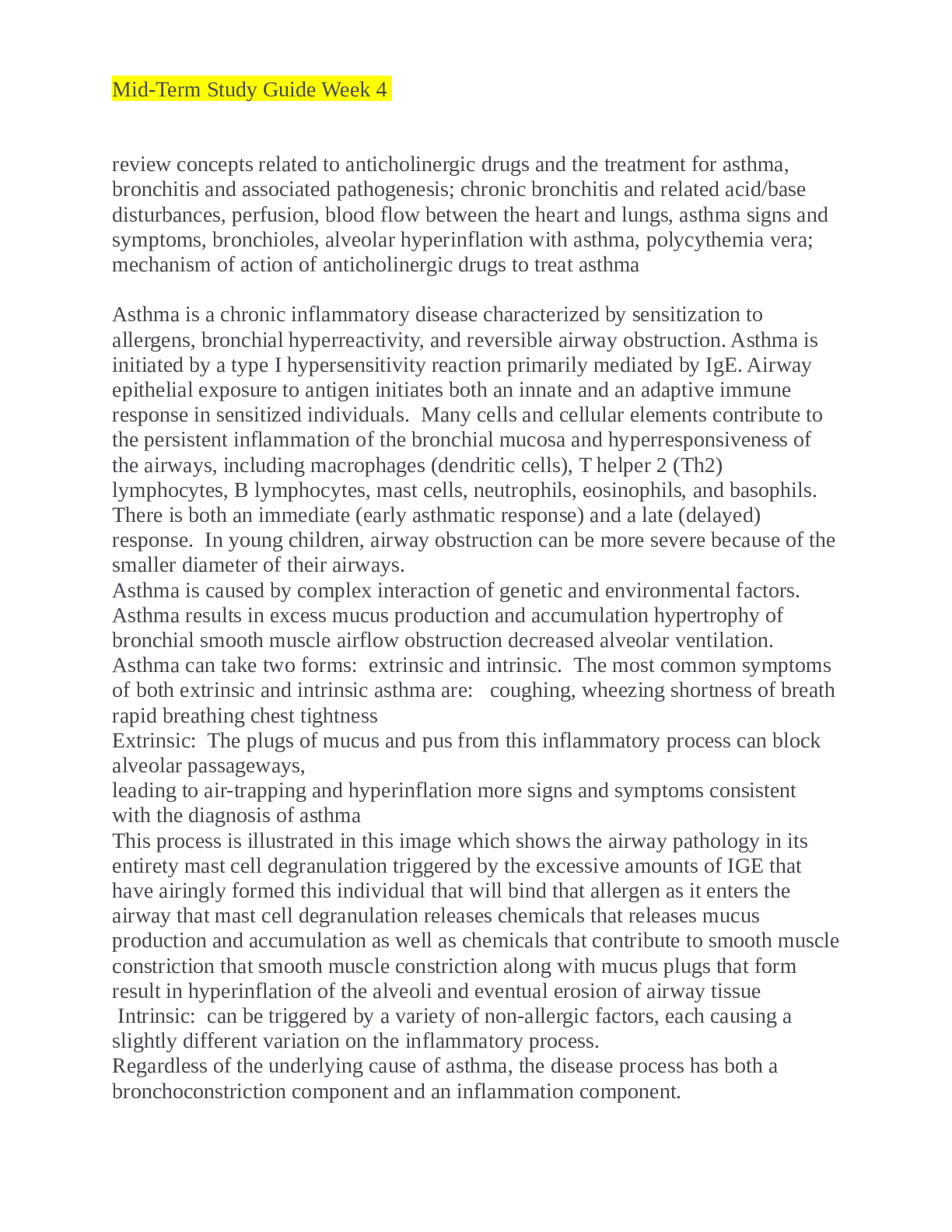
Buy this document to get the full access instantly
Instant Download Access after purchase
Buy NowInstant download
We Accept:

Reviews( 0 )
$13.00
Can't find what you want? Try our AI powered Search
Document information
Connected school, study & course
About the document
Uploaded On
Mar 19, 2022
Number of pages
45
Written in
Additional information
This document has been written for:
Uploaded
Mar 19, 2022
Downloads
0
Views
105








